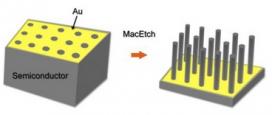Deep-Wet Etching Process Refined Enough to Attract Company Licensing
Researchers have refined a new, deep-wet etching process so significantly that companies now license the technology for potential semiconductor production. The research was conducted at the Nanomanufacturing Systems for Mobile Computing and Mobile Energy Technologies (NASCENT) center, an NSF-funded Engineering Research Center (ERC) with headquarters at the University of Texas at Austin.
Nanostructures offer new possibilities in shrinking and enhancing the performance of electronic devices, but so far have proven difficult to produce at scale. Breakthroughs in metal-assisted chemical etching (MacEtch or MACE) suggest the process can produce deep, high-quality grooves over a wide area and at relatively low cost.
In traditional semiconductor production, a patterned mask prevents etching, and the area that is exposed to the etchant is cut. In contrast, MacEtch relies on an unusual attribute in which a metal layer instead etches the silicon substrate; the metal layer functions as a catalyst to reduce oxidation and produce holes in the underlying silicon substrate.
MacEtch has the potential to enable atomically precise and smooth etching of semiconductor nanostructures. However, challenges have prevented the process from being deployed broadly in commercial applications. Center researchers have overcome a number of those barriers, including the substitution of elements incompatible with semiconductor production, including noble elements such as gold.
Researchers also have demonstrated reliable, wafer-scale etching at atomic resolution while simultaneously producing multi-scale structures (100nm to 10 microns).


